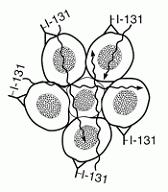Radioimunotherapy
Radioimmunotherapy
It uses a specific monoclonal antibody that binds to a particular tumor antigen, and thereby brings the tumor cells a source of radiation in the form of a radioactive isotope. Thereby, in the ideal case only the destruction of tumor cells, and the conventional generalized side effects of tumor therapies (nausea, vomiting, alopecia) are absent.
The antibodies used in the treatment of murine origin (IgG1 isotype). At their Fc fragment is a special technique attached isotope. When an anti-CD20 monoclonal antibody that binds to CD20antigen induce apoptosis of lymphoma cells by activation of complement and antibody-dependent cellular cytotoxicity. This is the principle of action of unlabeled antibody (rituximab), which are often used in the treatment of refractory NHL. The effect of such therapy was evident in 50% of patients, but complete response (complete response) was achieved in only 6% of them.
Radioimmunotherapy is particularly suitable for the treatment of non-Hodgkin's lymphoma (NHL) for several reasons:
1. Lymphomas are among the tumors are highly sensitive to radiation
2. Similar treatment the maximum quantity of radiation passes to the tumor tissue, as opposed to total body irradiation.
3. Anti-CD20 monoclonal antibody therapeutic effect on multiple levels. Besides induce apoptozustanica lymphoma by activation of complement and antibody-dependent cellular cytotoxicity, they bring the source of radiation directly into the tumor. In this way, unlike the unlabeled antibody, may be effective in the case where the patient's immune system is not fully active and can destroy the antigen-negative cells within the tumor, which is particularly important at low prokrvljenih tumors and larger tumor mass (Figure 1) .

Figure 1 Example of destruction of the antigen-negative tumor cells in the center of the tumor using I-131 (Eng. Crossfire).
Side effects in the case of both antibodies are divided into hematologic and others.
Due to bone marrow suppression approximately 5-8 weeks after the treatment period may occur pancytopenia (mostly neutropenia and trombocitopoenija). In the case of Zevalin 7% of patients had to be hospitalized due to infection, and 13% of patients required a leukocitopenijom application of growth factors to stimulate granulocytes. If Bexxar growth factors are applied in 15% of patients. Hematopoietic recovery typically takes 8-12 weeks after administration of the antibody.
From nehematoloških side effects usually include: weakness, abdominal pain, cough, nausea, vomiting, rash, headache, joint and muscle pain, diarrhea. The intensity of these side effects in most cases was moderate.
It is worth noting that the use of tositumomab and I -131 tositumomab can lead to the release of I-131 from the compound of the antibody, and he can then accumulate in the thyroid and lead to its damage, and hypothyroidism. Therefore, these patients need before and during treatment take medications that block the thyroid gland (potassium iodide). It does not matter in about 5% of them found elevated TSH after treatment.
It is possible that after the treatment with the antibodies raised concentration of HAMA (human anti-mouse antibodies) serum. These are antibodies that the patient's body creates to contain murine antibodies, which occurs in 0-5% of patients and usually have no clinical significance. Must be borne in mind only the eventual re-granting of murine antibodies.
